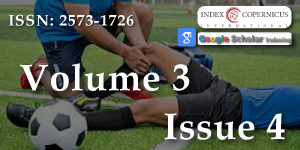Final solution in femoroacetabular impingement - Threaded cups in hip revision surgery 2002-2012
Main Article Content
Abstract
Purpose: Here, we report the complications of endoprosthesis with threaded cups according to our application in cases of complicated acetabulum (hip revisions and femoroacetabular impingement (FAI)).
Methods: A total of 504 patients was analyzed, including 189 men and 315 women. For re-implanted patients (n = 49), the mean time to re-implantation was 6.3 years and the average age at re-implantation was 54.7 years. For censored patients (n = 455), the mean time to censoring was 5.5 years and the average age of the implant was 55.7 years. Among the patients that were censored, 77 died and 378 patients did not experience an event necessitating re-implantation.
Results: For the total study population, the Kaplan-Meier estimate of 5 year survival is 0.94 and of 10 year survival is 0.85. 90% of the implants survived 7 years, 80% of the implants survived almost 12 years and 70% of implants survived almost 15 years. Kaplan-Meier survival analysis suggests that men have higher survival than women. Age of the patient at the time of implant was not a statistically significant factor for re-implantation (p value = 0.21) but sex was (p value = 0.02). Women had 2.25 times more risk of being re-implanted than men.
Conclusions: In our case series, the failure rate, as a result of aseptic loosening, was 7.4% (n = 51). More than half the failure cases (56%) required re-implantation. Over one-third (37%) of the primary arthrosis cases, were found to be FAI, lessening the frequency of diagnosis of the former. In our clinic, the threaded cup seems to be indispensable in hip revision surgery and in treating FAI.
Article Details
Copyright (c) 2018 Magersky S.

This work is licensed under a Creative Commons Attribution-NonCommercial 4.0 International License.
Apel DM, Smith DG, Schwarz CM, Paprosky WG. Threaded cup acetabuloplasty. Early clinical experience. Clin Orthop. 1989; 241: 183-189. Ref.: https://goo.gl/kBnsYP
Bruijn JD, Seelen RM, Feenstra RM, Hansen BE, Bernoski FP. Failure of the Mecring screw-ring acetabular component in total hip artroplasty. A three to seven-year follow-up study. J Bone Joint Surg. 1995; 77: 760-766. Ref.: https://goo.gl/avhNMx
Engh CA, Griffin WL, Marxc C. Cementless acetabular components. J Bone Joint Surg. 1990; 72: 53-59. Ref.: https://goo.gl/UhyKfK
Fox GM, McBeath AA, Heiner JP. Hip replacement with a threaded acetabular cup. A follow-up study. J Bone Joint Surg. 1994; 76: 195-201. Ref.: https://goo.gl/a3cxXb
Herberds P, Malchau H, Romanus B, Wiklund LM. Lord’s cementless total hip replacement in young patients: 2-7 years result. Orthop Trans. 1986; 10: 442-446.
Shaw JA, Bailey JH, Bruno A, Greer RB III. Threaded acetabular components for primary and revision total hip arthroplasty. J Arthoplasty. 1990; 5: 201-215. Ref.: https://goo.gl/RFyazv
Huiskes R. Finite element analysis of acetabular reconstruction. Noncemented threded cups. Acta Orthop Scand. 1987; 58: 620-625. Ref.: https://goo.gl/rRSd11
Kody MH, Kabo JM, Markolf KL, Dorey FJ, Amstutz HC. Strenght of intial mechanical fixation of screw ring acetaular components. Clin Orhop. 1990; 257: 146-153. Ref.: https://goo.gl/ZDc3Co
Maloney WJ, Smith RL. Periprostetic osteolysis in total hip arthoplasty. The role of particulate wear debris. J Bone Joint Surg. 1995; 77: 1448-1461. Ref.: https://goo.gl/xCbGim
Schmalzried TP, Jasty M, Harris WH. Perisprosthetic bone loss in total hip arthoplasty. Polyethylene wear debris and the concept of the effective joint space. J Bone Joint Surg. 1992; 74: 849-863. Ref.: https://goo.gl/1Rnqse
Tallroth K, Slätis P, Ylinen P, Paavolainen P, Paavolainen T. Loosening of threaded acetabular components. Radiographic manifestations. J Arthoplasty. 1993; 6: 581-584. Ref.: https://goo.gl/6ES6VE
Yiannakopoulos CK, Chougle A, Eskelinen A, Hodgkinson JP, Hartofilakidis G. (2008) Inter-and intraobserver variability of the Crowe and Hartofilakidis classification systems for congenital hip disease in adults. JBone Jt Surg.,90-B:579-583. Ref.: https://goo.gl/aTZvqS
Hartofilakidis G, Stamos K, Karachalios T, Ioannidis TT, Zacharakis N. Congenital hip disease in adults. Clasification of acetabular deficiencies and operative treatment with acetabuloplasty combined with total hip arthroplasty. J Bone Jt Surg. 1996; 78-A: 683-692. Ref.: https://goo.gl/QmQFiK
Hartofilakidis G, Stamos K, Karachalios T. Treatment of High Dislocation of the Hip in Adults with Total Hip Arthroplasty. J Bone Jt Surg. 1998; 80A: 510-517. Ref.: https://goo.gl/W2WLso
Cruz-Pardos A, García-Rey E, García-Cimbrelo E. Total Hip Arthroplasty with Use of the Cementless Zweymüller Alloclassic System: A Concise Follow-up, at a Minimum of 25 Years, of a Previous Report. J Bone Joint Surg Am. 2017; 99: 1927-1931. Ref.: https://goo.gl/7cQ8Hk
Li H, Zhang S, Wang XM, Lin JH, Kou BL. Medium-term results of ceramic-on-polyethylene Zweymüller-Plus total hip arthroplasty. Hong Kong Med J. 2017; 23: 333-339. Ref.: https://goo.gl/XsprHc
Christodoulou NA, Dialetis KP, Christodoulou AN. High hip center technique using a biconical threaded Zweymüller cup in osteoarthritis secondary to congenital hip disease. Clin Orthop Relat Res. 2010; 468: 1912-1919. Ref.: https://goo.gl/cjU74H
Busch VJ, Pouw MH, Laumen AM, van Susante JL, Vervest AM. Long-term outcome of 73 Zweymüller total hip prostheses with a screw cup in patients under 50 years of age. Hip Int. 2012; 22: 292-295. Ref.: https://goo.gl/2QCGWU
Bürkner A, Fottner A, Lichtinger T, Teske W, Vogel T, et al. Primary stability of cementless threaded acetabular cups at first implantation and in the case of revision regarding micromotions as indicators. Biomed Tech (Berl). 2012; 57: 169-174. Ref.: https://goo.gl/ux7qbz

